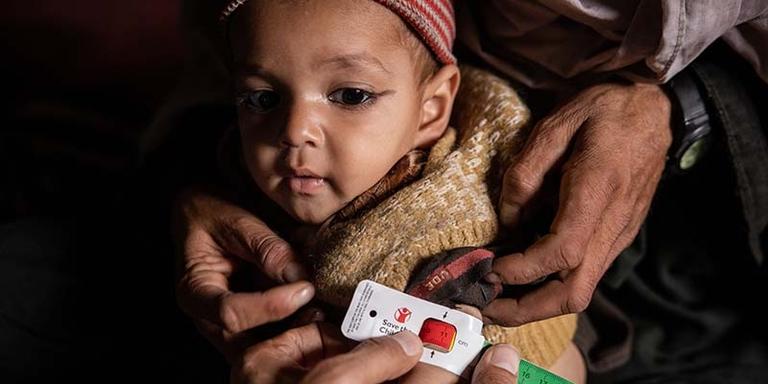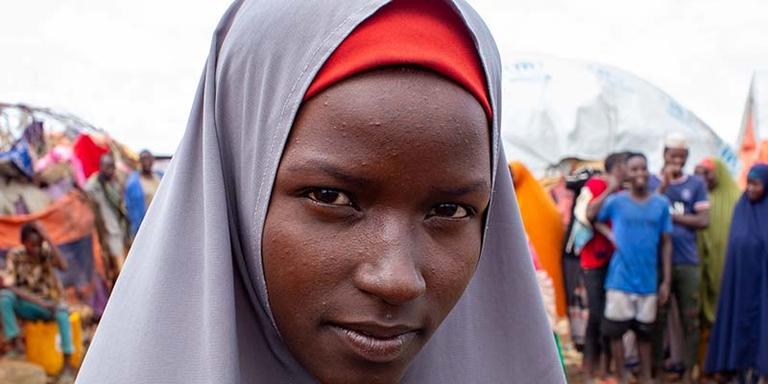
Save the Children supports the malnourishment program and meal program for mothers in a hospital in Aguie, Niger.
Children on the Brink: What We Must Do to Respond to the Global Hunger Crisis
Written by Greg Ramm, Head of the Department of Humanitarian Response at Save the Children US
I recently traveled to visit our programs in Burkina Faso where the hunger crisis is threatening the lives of children and families in a country already suffering from conflict and drought. This crisis extends across the Sahel and across West and Central Africa - the world’s most food insecure region in proportion to its population.
In Dori, in northern Burkina Faso, I visited a local clinic where Save the Children and Doctors of the World work to care for children with severe acute malnutrition. I have visited centers like these before but it’s always shocking to see such desperate conditions.
Even though the clinic had around 20 babies and infants in its care, the place was eerily quiet. These children were using what little energy they had to simple stay alive.
Similar clinics across the Sahel and around the world are dealing with an increase in children suffering from severe acute malnutrition.
The combined impact of conflict, climate change, COVID-19, and the cost of soaring food prices from the conflict in Ukraine is behind the worst global hunger crisis in decades.
A perfect storm of shocks has left up to 750,000 people facing near-famine conditions right now. It’s nearly impossible to imagine, but another 49 million more people are in need of immediate, emergency food assistance.
It is not an exaggeration to say that failure of the international community to act now will prove catastrophic, and time is running out to save the lives of millions of children.
“It is deeply alarming and frankly shameful that the number of people going hungry is on the rise. If we fail to act now, many lives will be lost and years of development gains will go down the drain…families have told our staff they are eating putrid meat, drinking dirty water from cattle troughs, and fighting off wild animals for whatever they can get their hands on to eat. Nobody should have to live like this.”
- Gabriella Waaijman, Global Humanitarian Director at Save the Children
In any severe food crisis, children are always the most vulnerable. Malnutrition caused by extreme hunger is one of the biggest killers of young children around the world today. And yet it is entirely preventable. We don’t need to spend billions on researching a cure or developing a vaccine. We know how to treat malnutrition and we know how to prevent it.
Personal stories from countries struggling with hunger are strikingly similar and food insecurity almost always affects people who are already suffering from persistent poverty and inequality.

Ninangyali*, 1, being assessed for malnutrition at a mobile health clinic in Jawzjan, Afghanistan.
Treating Malnutrition in Afghanistan
Afghanistan is trying to transition out of decades of war but is now in the grip of an economic crisis. For the first time since records began in Afghanistan, people are facing catastrophic, famine-like conditions.
Our teams are delivering essential health and nutrition services through 66 mobile teams across eight provinces, including screening and treating children under age five for acute malnutrition.
We’re treating children like one-year-old Ninangyali* - his family fled to escape conflict and sought refuge in a camp in the desert. Without enough food to eat, Ninangyali became thin and weak. Although the family took him to a hospital, they were unable to afford the treatment he needed. Thankfully, Ninangyali was able to receive treatment at one of our mobile health clinics. The doctor there said that his condition was so bad that he almost certainly would have died if we had not treated him.

Bishaaro*, 17, lives with her family in a displacement camp in Baidoa, Somalia.
Supporting Displaced Families in Somalia
More than 18.4 million people in Somalia, Ethiopia and Kenya are now facing acute food insecurity. About 7.1 million of them are Somalis — nearly half the nation’s population — with almost 250,000 at risk of imminent starvation.
These conditions have impacted families like Samia*, 12, and Suad*, 55, who live in a displacement camp. Suad arrived at the camp in May with her seven children and disabled mother after the drought killed off her livestock and, as a result, her livelihood.
We will be providing Suad with cash payments every month for the next year to help her afford food and basic essentials. We know from years of responding to emergencies that cash assistance is the most effective way to reach the most vulnerable households – it provides families with the power to decide for themselves what they need.
We are also provided clean water to people like Bishaaro*, 17, who lives with her family in another displacement camp in southern Somalia. Just like Samia and Suad, her and eight family members were forced to flee their homes after they lost their livestock due to drought.
In the camp, Bishaaro says they only eat one meal a day and need essentials like food, water, and access to schooling. Save the Children is supporting families like Bishaaro’s by providing safe, potable water through water trucking to drought-affected areas.
What You Can Do for Children
Save the Children is providing critical support across 21 countries where extreme hunger threatens to claim thousands of children’s lives and futures over the next few months.
We are already distributing food and cash and supporting families’ livelihoods to stop children from going hungry. We are also working with partners to help communities spot the early warning signs of conditions that can lead to hunger, so they can take measures to protect themselves and mitigate against the worst impacts.
I have seen the incredible impact we can have when the world rallies to support children in crisis. We did it for children in Ukraine earlier this year, and in the Horn of Africa in 2017 when famine was averted. Sadly, we have also seen the impact when we don’t act or delay. In 2011, Somalia experienced a devastating famine that killed over a quarter of a million people – half of them children under the age of five.
We must not let history repeat itself. Millions of children can be saved through our efforts and through the commitment of people like you. But the window of opportunity to avert widespread famine is closing fast. I am urging you to join our efforts now, before it’s too late.
Learn how you can join our efforts in responding to the global hunger crisis>>
*Names changed to protect privacy
Greg Ramm is the Head of the Department of Humanitarian Response at Save the Children US, and has worked for Save the Children for over 20 years. Most of Greg's time with Save the Children has been in Africa, initially as Country Director in the Democratic Republic of Congo and then in Ghana. Greg also served as Head of Regional Office for Southern Africa, as Regional Director for West and Central Africa, based in Dakar, Senegal and as Deputy Director of Global Programmes, based in London. Prior to returning to Africa and joining Save the Children, Greg was Executive Director of the Institute for Community Economics.
